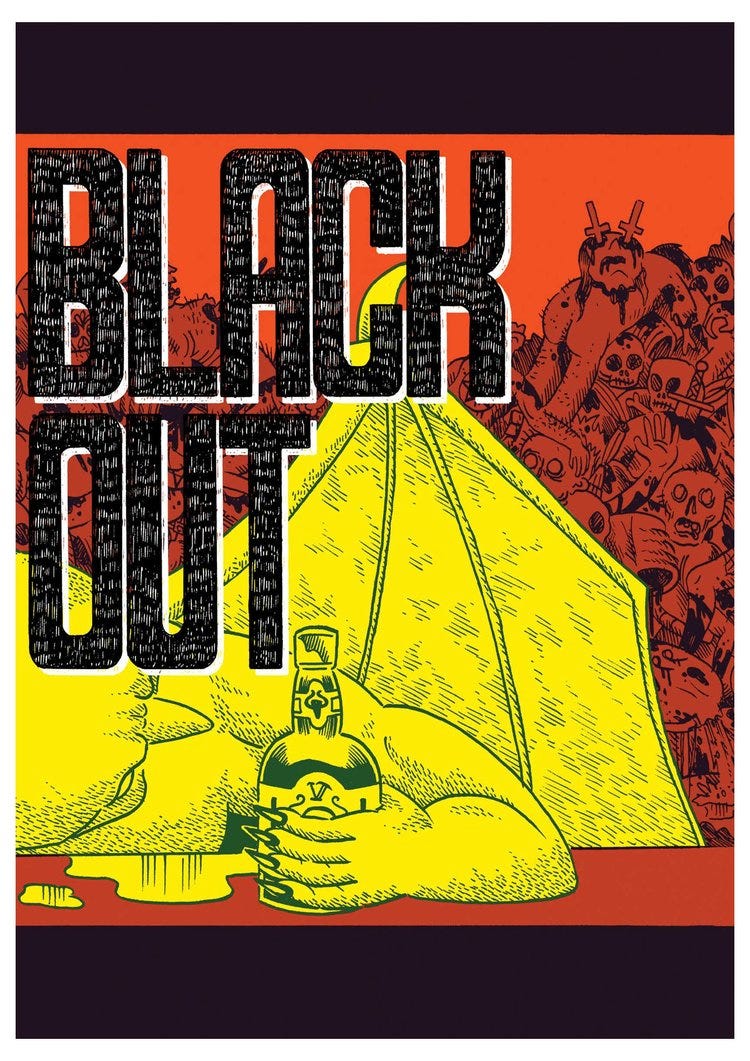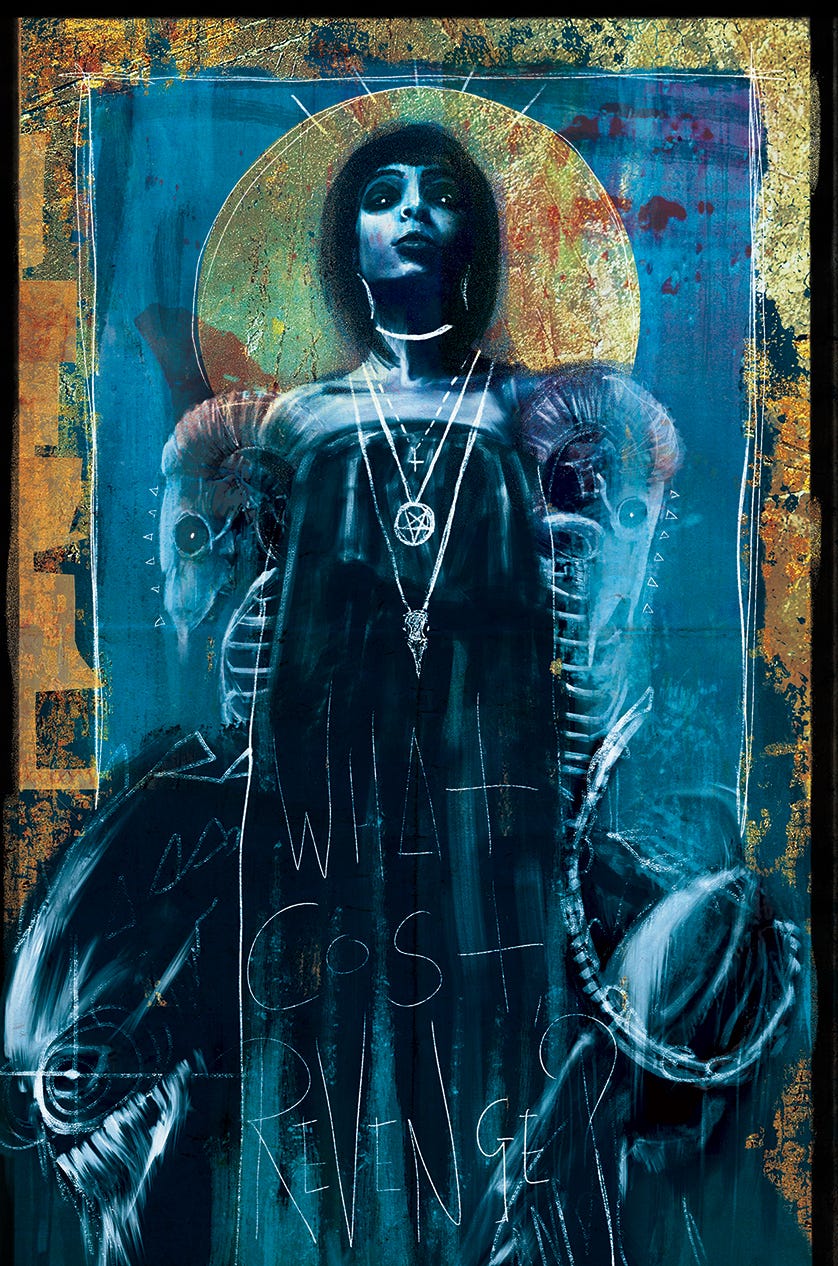Introductions!
The first issue of IF YOU GO AWAY, the newsletter about BLOOD MOON, folk-horror, new comics & breaking in as a writer

I’ve loved comics for almost as long as I’ve loved monsters, which is all of my life. My parents were very young when they had me and split up not long after I was born, but during the brief period when they were together in the early eighties, my dad would drive my mother crazy by spending all of his money on comics and throwing them away after reading them.
My mother decided to collect those comics for when I got older, and when I was around 8 years old she retrieved those massive crates from our loft and gave them to me. Overnight I gained a massive collection of American comics and Marvel UK reprints, honing in on Chris Claremont and John Byrne’s Uncanny X-Men as the focal point for my love of the medium.
Since then, I wrote a dissertation about comic-books as representations of the historical periods that they were created in, as part of my English Literature degree. I dealt with depression as a teenager by creating my first self-published comic, EVERYTHING IS GOING TO BE ALRIGHT. When it was first opened, I worked for three years in Travelling Man Newcastle, one of the UK’s best comic shops (occasionally working alongside the artist that would go on to become Tula Lotay).
During that time I more-or-less read every comic in stock and in print, soaking them up like a sponge, and started making black-and-white anthology comics with my co-workers Phillip Marsden, who went on to work regularly as an illustrator for NME and Kerrang! magazines, and with Jack Fallows, creator of the brilliant Cryptogram Puzzle Post.

For those first, early DIY comics, I would write and draw my sections myself, badly, like a child, but taking months longer than any child would take to create such awful illustrations. That continued until I reached a stage where I could begin to persuade other artists that I was a good enough storyteller to collaborate with by letting me write scripts for them. During this period I got a job working in a public library in Greater Manchester, where I ran graphic novel reading groups for teenagers that started with one girl attending every month and ended up having to be split by age groups, because I’d regularly have to manage a ridiculous amount of overly enthusiastic teenagers meeting in a tiny space, where we’d hold all kinds of workshops and events with comic pros.
Eventually the early black-and-white BLACKOUTs gave birth to the full-colour BLACKOUT and BLACKOUT II: YOLO anthologies, arguably the first comix that I felt were good representations of the kind of art I wanted to make. That led to the first issue of LA BELLE DAME SANS MERCI (conceived as an entry to the Myriad Editions First Graphic Novel Competition), LOVE WILL TEAR US APART, and my first collaboration with artist Martin Simmonds for Disconnected Press, and all the amazing opportunities and pitfalls that have followed.

I’m P M Buchan and I’ve started this newsletter in the run-up to the digital release of BLOOD MOON, my ongoing folk-horror series co-created with John Pearson, Aditya Bidikar and Hannah Means-Shannon. BLOOD MOON is a labour of love that is the purest distillation to date of what goes on inside of my head, the things I care about and the things that keep me awake at night. We’re going to release the pages of BLOOD MOON first to John’s Patreon backers, and later as an ongoing webcomic. Which is essentially our way of admitting that John needs to pay to keep the lights on for as long as it takes to finish the damn thing, but we also want everybody to be able to read it as easily as possible. Time delay is our compromise.
This newsletter, like our lives, is a work-in-progress. If you see anything that you particularly like or loathe, let me know. I’m going to start by sending this out every other week, to see how manageable that schedule is, and take it from there. I’m going to include updates on upcoming comics, reflections on failed pitches, playlists (because my world revolves around music) and interviews with other writers, artists, editors, directors and musicians.
---
Spotify playlist of the week: 1998-ish
Delving into my past has led me on an uncharacteristically nostalgic journey into music from my youth recently, so I created this Spotify playlist of stuff that I was listening to at the end of the 1990s. Very much a collection of rock, metal and punk, a lot of which came from Kerrang! And Metal Hammer cover discs, because when you were a teenager in the 90s you didn’t have unlimited access to stream all the music in the world - you had access to compilation cover discs, whatever was played on the radio, and whatever you could copy from your friends!
---
I first encountered Maria J. Pérez Cuervo through her work on John Reppion’s ‘Spirits of Place’, alongside writers like Alan Moore and Warren Ellis. Her love of folklore and everything Gothic really resonated with me, so I was incredibly excited when I learned that she was editing a new limited-run magazine inspired by British folk-horror, so I caught up with Maria to find out more.

1/ What is Hellebore and why did it need to exist?
Hellebore is a limited-run magazine devoted to British folk horror and the occult. So much of the content we consume is digital that print feels like a small luxury. I became obsessed with the idea of putting together something that was physical rather than digital, and beautifully designed, and I wanted to do it about the themes that I love, and with writers, academics, and artists whose work I admire. I'm pleased it seems to have resonated with many other people.
2/ What would issue two feature if you could reanimate any dead artist of your choice to interview or converse with?
I'd interview Margaret Murray, whose Witch Cult theory was hugely influential in the early 20th century and beyond. She was a fascinating character. And I'd love to include some original art by Pamela Colman Smith, best known for illustrating the Rider-Waite-Smith tarot. I'd also talk to Eleanor Scott and Margery Lawrence, who penned fantastic folk horror stories. Both of them seem largely forgotten, unlike James, Blackwood, and Machen, the names everyone thinks of when you're talking about the origins of folk horror. So much of folk horror seems very male-dominated, but there were, and there are, many women contributing to it.
3/ Why British folk horror? What does Britain mean to you?
I grew up in the south of Spain, one of the sunniest places in the world, but I never felt I belonged. I became fascinated with Britain by reading the stories of the Famous Five, largely because of the settings: the Cornish coast, the moors, the ancient ruins. I think this had a huge impact on me. I've been living in England for 15 years and I still feel it's the place that lived in my imagination, with all its ghosts, its ruins, its tormented lovers, and its strange folklore. Hellebore is about that land, and the stories it tells us.
But I was also aware of the current political situation, and I wanted to make a political statement. This is why I asked David Southwell to write about the political meaning of landscape, and about the role of folklore in fighting fascism. He explains - much better than I could - that re-enchantment is resistance. And this is why I write that Hellebore is our contribution to the resistance.
4/ Without limitations, budgets or modesty, what would you make next?
A TV series. I've co-written some treatments, but having no contacts means it's impossible to be heard. I have a novel planned that contains many of the obsessions that drive Hellebore. It'll hopefully happen some day.
Maria J. Pérez Cuervo is a freelance writer and the editor of Hellebore. Her work has appeared in Fortean Times, Mental Floss, The Order of the Good Death, and the Daily Grail, among others. Find her on Twitter as @mjpcuervo.
---
That’s it for the first issue of IF YOU GO AWAY!
Subscribe for more news next time about the launch of BLOOD MOON, more esoteric interviews and stories about how I broke into writing for horror mags after a lifetime of wanting to be a writer but doing very little about it.
If you want to discuss anything that I’ve mentioned so far, I pretty much live on Twitter @PMBuchan, so that’s the best place to find me.
